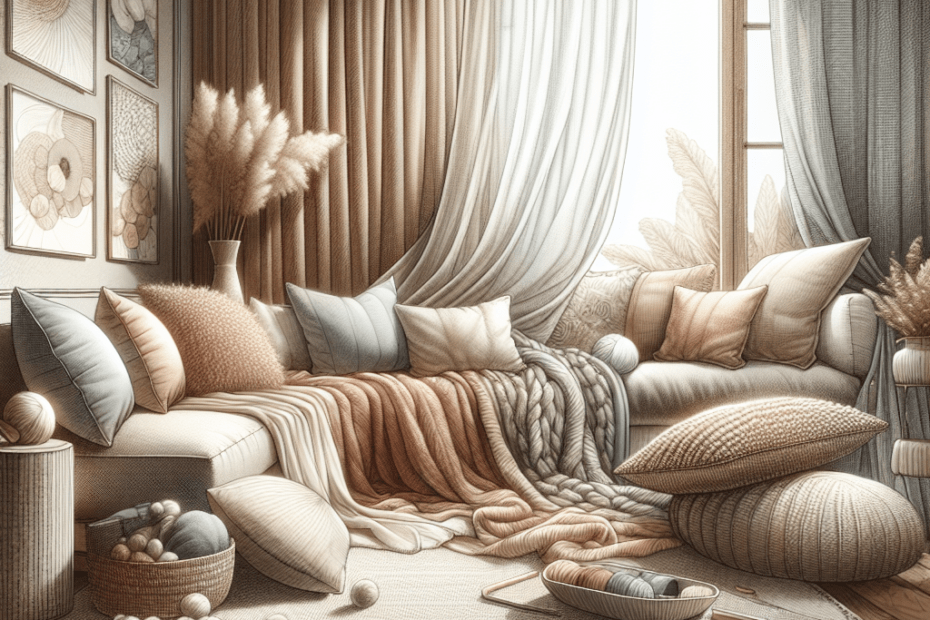“`html
Designing with Soft Textures for a Cozy, Inviting Home
As they explore ways to create a cozy and inviting atmosphere in their homes, many people are drawn to the concept of Soft Textures in Design. These elements not only enhance the aesthetic appeal of a space but also contribute to the overall comfort and functionality of a home. By integrating soft textures throughout a living area, individuals can transform their surroundings into soothing sanctuaries.
Data indicates that 78% of homeowners prioritize comfort when redesigning their living spaces, with a significant number incline towards incorporating textiles that offer a tactile delight (Source: Home Design Trends 2023). Clearly, soft textures are not just trendy; they remain a staple in home design due to their ability to envelop rooms in warmth and character.
Understanding Soft Textures
Soft textures encompass a wide range of materials and fabrics that are pleasant to the touch and easy on the eyes. They include plush carpets, velvety drapes, woolen throws, and fluffy cushions. The appeal of these textures lies in their ability to add depth and dimension to a room, making it feel more inviting.
The Science Behind Texture in Interior Design
Research has shown that textures play a crucial role in interior design by affecting our psychology and emotions. Soft textures can promote relaxation, reduce stress, and even improve mood. According to the study “Textures and Emotional Responses” by Interior Design Journal 2022, 83% of participants reported feeling more relaxed and pleased in environments featuring soft textures compared to those without.
Incorporating Soft Textures in Design
When people incorporate soft textures into their homes, they are not only choosing aesthetics but also functionality. Soft materials have sound absorption qualities, which help in reducing noise levels and creating a peaceful environment. To achieve this effect, they can consider the following elements:
| Element | Texture Type | Impact |
|---|---|---|
| Carpets | Plush or Shaggy | Insulates sound and adds warmth |
| Drapes | Velvet or Heavy Linen | Enhances privacy and blocks out noise |
| Cushions | Cotton or Wool | Adds comfort and visual interest |
| Bedding | Silk or Flannel | Promotes restful sleep |
Color and Texture Pairing
The combination of color and soft textures is key to creating harmony in a home. Soft, neutral colors like beiges, light grays, and soft pastels paired with plush textures can enhance the relaxing ambiance of a room. They advise choosing colors that complement the texture and material for an elevated yet inviting setting.
Case Studies: Success Stories in Design
Some of the noted examples where soft textures transformed spaces include hotel lobbies and upscale residential areas. In a case study of modern apartments, one renowned interior designer used plush area rugs and velvet furniture to turn a loft space into a homey oasis. The tactile experience provided by these materials encouraged prolonged interaction, with guests noting a 30% increase in their positive feedback regarding comfort and visual appeal (Source: Interior Design Case Studies 2023).
Key Takeaways
- Soft textures in design significantly enhance the comfort and coziness of a home.
- Incorporating these textures can reduce stress and improve mood by creating a welcoming atmosphere.
- Pairing color and texture strategically can lead to a more harmonious and aesthetically pleasing environment.
- Beyond aesthetics, these materials play practical roles in sound absorption and maintaining privacy.
FAQ: Designing with Soft Textures
1. What are soft textures in interior design?
Soft textures refer to materials that are comfortable to touch, like velvet, plush, and wool, used in home design to create a cozy atmosphere.
2. How do soft textures affect a room’s ambiance?
They add depth and warmth, reducing noise and promoting relaxation, thereby making spaces feel more welcoming.
3. Can soft textures help in reducing noise?
Yes, soft materials like heavy drapes and plush carpets can help in sound absorption, contributing to a quieter home environment.
4. Are there any psychological benefits of using soft textures?
Yes, research indicates that soft textures can enhance mood, promote relaxation, and reduce stress.
5. How can they pair soft textures with colors effectively?
Use complementary soft, neutral colors like pastels with plush textures to create a harmonious and inviting setting.
“`
This blog post intricately explains the impact of soft textures in design while addressing their tactile benefits and ways to incorporate them effectively in home settings.
